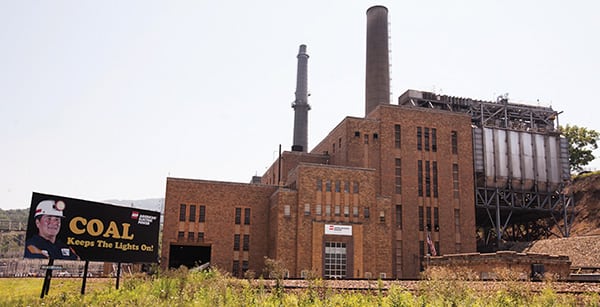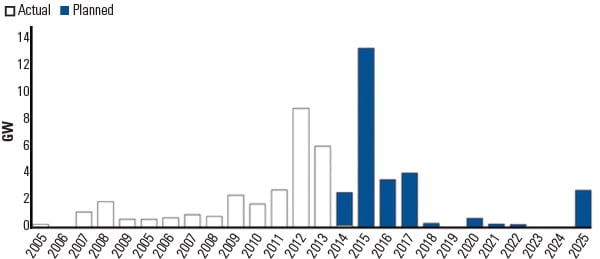Supporting Coal Power Plant Workers Through Plant Closures
With dozens of U.S. coal-fired units closing, workers who aren’t ready for retirement will be seeking new employment. Here’s a rundown of programs and resources designed to assist them.
Coal-fired power plants around the U.S. are closing—rapidly. It’s a trend that will continue for the foreseeable future as dozens more units are slated for closure in the next few years. According to a recent study by the Energy Information Administration (EIA), nearly 18 GW of electric generating capacity was retired in 2015. More than 80% of that amount was conventional steam coal generation, typically older and smaller units.
In an August 2014 report, the U.S. Government Accountability Office (GAO) stated that 13% of coal-fueled generating capacity—42,192 MW—had either been shuttered since 2012 or was planned for closure by 2025.
The amount of coal capacity retired in 2015 was about 4.6% of the nation’s coal capacity at the beginning of that year. Nearly half of the 2015 affected capacity was located in three states—Ohio, Georgia, and Kentucky—and those states each retired at least 10% of their coal capacity last year. Other states that traditionally have had high levels of coal-fired electricity generation, such as Indiana, West Virginia, and Virginia, each shuttered at least 1 GW of capacity in 2015.
About 30% of the coal capacity that retired in 2015 did so in April, which is when the U.S. Environmental Protection Agency’s (EPA’s) Mercury and Air Toxics Standards (MATS) rule went into effect. Some coal plants applied for and received one-year extensions, and they are now in the process of ceasing operation. In fact, Platts reported that 2,000 MW of older Midwest coal-fired capacity, mostly in Indiana and Michigan, retired on a single day, Friday, April 15. Several plants have received additional one-year extensions beyond April 2016 based on their role in ensuring regional system reliability.
The GAO projected that the year with the most closures would be 2015 (Figure 1), and, as the EIA number cited above confirms, it was. In other words, the worst is over.
But even though many reports identify the number of megawatts going off-line, few data exist for how many coal plant workers are losing their jobs or being affected as the industry begins to pivot away from coal. Just like the miners who are hurting as the U.S. coal industry crashes around them, many coal plant employees fear they are facing a similar tsunami. What examples exist for successful transitions, and what help is there for those caught in the storm?
How Generating Companies Are Assisting Affected Workers
Much of the existing coal generation capacity in the U.S. was built from the 1950s to the 1990s during a time when electricity sales were growing much faster than population and gross domestic product. The coal units that were retired in 2015 were mainly built between 1950 and 1970, and the average age of those units was 54 years. According to the EIA’s research, the rest of the coal fleet that continues to operate is somewhat younger, with an average age of 38 years.
The units closed in 2015 also tended to be smaller than the rest of the coal fleet. The net summer capacity of the average retired coal unit was 133 MW, compared with 278 MW for the units still operating. Often because they were older, some of these plants required larger workforces to operate and maintain per megawatt of capacity.
Just like the facilities they work in, the average age of workers at many coal-fired power plants nationwide has steadily crept upward as many anticipated eventual retirement. There are several important contextual factors to remember when considering job losses in the coal-fired generation sector:
■ The average worker at a coal plant is over 50 years old.
■ The average coal plant has multiple units.
■ Retirements always happen with multiple years of forewarning.
■ Some generating companies have been able to move workers from coal-fired to newer gas-fired plants.
All things considered, with careful planning, in many instances staff numbers have painlessly dropped at a given location through natural attrition, without layoffs.
An example of a successful transition occurred in Holland, Michigan, recently. Just before tax day this year, the 76-year-old James De Young Power Plant on the shore of Lake Macatawa (Figure 2) fired up two natural gas–powered units as the plant finally converted away from coal. Owned by the Holland Board of Public Works (BPW), a mid-April date to stop burning coal had long been in the BPW’s plan, said Dave Koster, general manager of the BPW. The Holland Sentinel newspaper reported that there were about 35 workers at the plant who will be moving in shifts to the new Holland Energy Park as they gain training for their careers in natural gas and other energy systems.
Koster told the paper that no layoffs are needed. “It’s been a key power resource that helped make our electric system reliable and cost effective for the development of businesses in our area and I’m glad we’ll be able to transition our staff over to the new plant.”
Likewise, for generation behemoths such as the heavily coal-dependent American Electric Power (AEP), careful planning helped save many jobs (Figure 3). By early 2016, AEP will retire more than 6,000 MW of coal-fired generating capacity at 11 power plants in seven states. Typical of these older plants slated for retirement is AEP’s Philip Sporn Plant near New Haven, West Virginia, though the adjacent Mountaineer 9 plant is not.
 |
|
3. Gone but not forgotten. American Electric Power’s (AEP’s) Kanawha River Plant, located on the Kanawha River at Glasgow, W.Va., was retired in mid-2015. Courtesy: AEP |
In total, AEP had approximately 570 positions that were affected by upcoming generating unit retirements. As early as 2012, when the company identified the 23 coal-fueled generating units at nine sites that would close due to MATS and other environmental regulations, “We specifically held positions that came open (due to retirements or people leaving) at other power plants not being closed to help reduce the job impacts from the generating unit closures,” said Melissa McHenry, director of external communications at AEP in an email to POWER. “That meant new positions at other power plants or other AEP departments for nearly half of the employees affected by the retirements. Many of the affected employees also were retirement-eligible, so they decided to retire instead of taking another position that might have required relocation or longer travel time.”
Most of the job changes within AEP were for similar types of jobs at another power plant. “There were a few employees who decided to train for line mechanic jobs in our transmission and distribution organizations or for other jobs at AEP in order to stay with the company,” said McHenry. Since most of the affected employees were able to transfer within AEP or were retirement eligible, the company did not use any government retraining programs to help with the transition. Many of the new positions were at other remaining coal plants, but several employees did go to some of AEP’s natural gas generating units. Though certainly there are still jobs “at the coal units that we refueled with natural gas, it takes a much smaller number of employees to operate a natural gas plant—25 or so for a good-size natural gas plant versus well over 100, sometimes nearly 200, for a good-size coal unit,” said McHenry.
Though AEP prepared employees for transitions in anticipation of MATS going into effect, the Obama administration’s Clean Power Plan (CPP), under judicial review, would have even larger effects and displace more workers.
POWER and POWER+
In response to the fierce debate arising out of the controversial CPP, late last year the Obama administration attempted to soften some of its potential blows by announcing a series of economic revitalization grants. Those resources, which benefited towns and nonprofit organizations throughout coal country (particularly Appalachia) are only the tip of the federal funding iceberg.
Last year, as part of President Obama’s effort to assist communities negatively affected by changes in the coal industry and coal power sector, the administration announced 36 awards totaling $14,546,457 for partnerships in 12 states and tribal nations that are seeking to build a more diversified and better economic future for their communities, businesses, and workers.
The Partnerships for Opportunity and Workforce and Economic Revitalization (POWER) Initiative is an administration effort, involving multiple federal agencies, with the goal of effectively aligning, leveraging, and targeting a range of federal economic and workforce development programs and resources to assist affected workers.
The POWER Implementation Grants Federal Funding Opportunity (FFO) was released in May 2015 with available funding from the Economic Development Administration (EDA), the Department of Labor’s Employment and Training Administration (ETA), the Small Business Administration (SBA), and the Appalachian Regional Commission (ARC). The FFO made funding available to partnerships in affected communities to help them:
■ Diversify their economies.
■ Create jobs in new or existing industries.
■ Attract new sources of job-creating investment.
■ Provide a range of workforce services and skills training for high-quality, in-demand jobs.
As part of fiscal year 2016’s budget, the POWER Plus Plan (POWER+) promises to invest roughly $10 billion more into a set of coal country goals, including economic diversification, environmental cleanup, health, and retirement security for workers. It also provides new tax incentives to support clean coal technologies “because coal will continue to be a critical part of the energy mix in this country and around the world.”
The 2016 federal budget provides $20 million specifically to support workers dislocated from coal mines and coal-fired power plants. Along with funding already provided through the Department of Labor’s Dislocated Workers National Reserve, this will allow states and local areas to provide reemployment, training, and supportive services to transitioning coal economy workers to help them get back to work in good jobs and careers.
A separate resource is the DOL’s National Reserve, which provides grants to states that have recently experienced a significant dislocation event, such as a mass layoff or plant closing. These funds supplement job training formula grants to temporarily expand the capacity of states and local communities to provide reemployment services, job training, subsidized employment, and supportive services to help unemployed workers get back on the job.
Another potential resource is the EPA’s Brownfields Program. The EPA provides grants to communities to assess and clean up brownfield sites—properties whose reuse may be complicated by the “presence or potential presence of a hazardous substance, pollutant, or contaminant.” The budget includes increased funding for the Brownfields Program, of which $5 million is designated exclusively for grants targeted to communities affected by the retirement of coal-fired power plants.
Assistance for Appalachia
The Appalachian Regional Commission is a regional development agency created to assist economic growth in Appalachian communities. Funds are awarded through a cooperative process with the governors of the 13 states that make up Appalachia. The 2016 federal budget provides $25 million for ARC, which will be directed specifically to those Appalachian communities most affected by coal economy transition and will support a range of economic development planning and implementation activities, including developing entrepreneurial ecosystems, facilitating access to capital investments and new markets, and addressing barriers related to adequate water, sewer, and telecommunication infrastructure.
These grants can and should be accessed by retiring power plant workers and affected personnel, said Wendy Wasserman, the ARC’s director of public affairs in Washington, D.C. “We take a holistic view of the economic impact of the changing economy on communities. Anything and anyone that is part of the entire coal transition, from the miners to the power supply chain and logistics, is eligible for some of these grants or funds. Through the POWER initiative, a congressionally appropriated activity that’s part of the Obama administration’s Power+ Plan, we are now distributing funds and helping communities along that supply chain begin to revitalize and diversify their economies,” said Wasserman in a phone interview with POWER.
“We’re inviting communities along those supply chains to develop comprehensive projects for their ‘labor-shed’ and to think about ways to create more economic opportunities,” she said.
In March, along with ARC partners at the EDA, “we announced the availability of over $65 million to apply for both technical assistance as well as project funding. Currently, we’re conducting a series of regional public workshops to help see what is possible and get people and projects up, running, and off the ground,” said an excited Wasserman. “We also have a large resource base to fund existing projects and new initiatives that have been in development up until now. But top line for us is to help with the impacts of our nation’s transition away from coal,” she said.
When asked about specifics, about what employees or plant managers who know their jobs or facilities are going to be phased out could do, Wasserman suggested reaching out and talking to the appropriate state personnel. “If I were an HR manager at a plant that I knew was scheduled to close, I would get in touch with the appropriate ARC state people and see if there were any on-going projects that could be helpful. That’s where the knowledge base is for the ARC. Their job is to make sure that our funds are used to improve the economic health of the communities we serve from the ground up. They might also be able to link you up with another partner. There are dozens of smaller-sized projects that could be exactly what is needed to help some workers transition to another career path. Bottom line, if you’re a power plant worker and you’re being laid off, if we can help you, we will,” said Wasserman.
To reach ARC state program managers, visit www.arc.gov/about/StateProgramManagers.asp. The group also produced a detailed March 2016 report on the state of the Appalachian coal industry that can be found at http://1.usa.gov/1QBjyBe.
Recent Grants
Below are some examples of recently awarded grants from ARC, the DOL’s ETA, the Department of Commerce’s EDA, and other entities.
$75,000 ARC grant to Appalshop Inc., in Whitesburg, Ky. This grant is for Mines to Minds: Southeast Kentucky High-Tech Workforce Training. The ETA is also awarding $200,000 to this project. ARC funds will be used to purchase digital multimedia supplies and equipment and to fund the creation of a technology and digital workforce development training curriculum in collaboration with area educators and regional employers.
$2,000,000 ETA grant to the Ohio Department of Job and Family Services in Columbus, Ohio. This project will provide training, work-based learning, and supportive services to dislocated coal miners and other dislocated workers affected by mass layoffs in the coal industry, for re-employment in the growing oil and gas industry in Ohio.
$2,000,000 ETA grant to the Kentucky Education and Workforce Development Cabinet in Frankfort, Ky. EDA is also awarding $1,000,000 to this project, and ARC is awarding $75,000. The project will provide training, work-based learning, and supportive services to dislocated coal miners and other dislocated workers affected by mass layoffs in the coal industry to retrain them for high-demand, high-wage positions in broadband service, fiber installation, and information technology (IT).
$147,900 to the Navajo Tribal Nation Government. This grant is for development of an economic recovery strategy to address negative effects associated with job losses from closures of coal mines and future closure of a coal-fired power plant.
$1,400,000 EDA grant to San Juan College in Farmington, N.M. The Four Corners POWER Initiative will provide re-employment services to workers affected by the changing regional energy economy and implement innovative partnering strategies with employers in expanding IT, healthcare, and renewable energy sectors.
$124,000 to Lewis County Economic Development in Chehalis, Wash. This grant is for an economic diversification and revitalization plan to mitigate job losses from the closure of a local coal-fired power plant.
$600,000 EDA grant to the Coalfield Development Corporation in Wayne, W.Va. This grant will support the Coalfield Development Corporation’s Regional Economic Diversification Project. ■
— Lee Buchsbaum (www.lmbphotography.com), a former editor and contributor to Coal Age, Mining, and EnergyBiz, has covered coal and other industrial subjects for nearly 20 years and is a seasoned industrial photographer.


